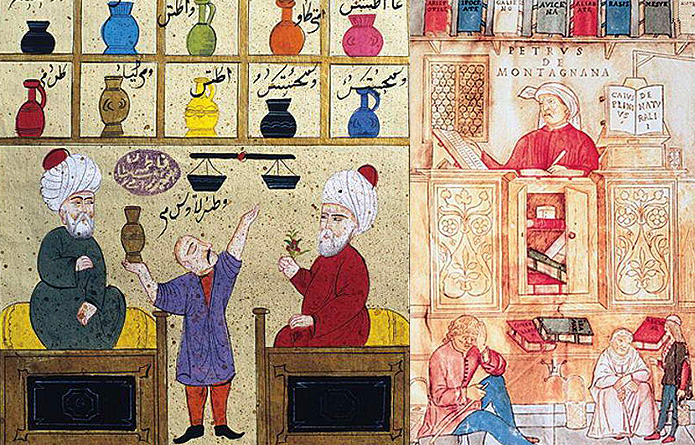
Using an Astrolabe
by Emily Winterburn Published on: 10th August 2005
The history of the astrolabe begins more than two thousand years ago, but it is in the Islamic classical world that the astrolabe was highly developed and its uses widely multiplied. Introduced to Europe from…

Star-finders Astrolabes
by Cem Nizamoglu Published on: 7th September 2017
Over a thousand-year period in Muslim Civilisation, epoch-making discoveries and contributions, such as the first record of a star system outside our own galaxy were made. Also astronomical instruments including celestial globes, armillary spheres, sextants…

Conference on “Astrolabes in Medieval Cultures” at the Warburg Institute in London (24-25 April 2014)
by The Editorial Team Published on: 1st April 2014
In the frame of the research project ‘Astrolabes in medieval Jewish society’, the Warburg Institute organizes a conference in London on 24-25 April 2014. The topics covered by this conference will be the astrolabe itself,…

Oxford Museum of the History of Science Online Al-Mizan Exhibition
by Sairah Yassir-Deane Published on: 16th November 2017
The Oxford Museum of the History of Science launched an online Al-Mizan Exhibition, this exhibition explores the connections between the sciences and arts in societies from Muslim Civilisation.

Al-Khalili and the Culmination of Spherical Astronomy in 14th-Century Damascus
by David A King Published on: 9th June 2016
Syria in the 14th century was the scene of the most sophisticated developments in astronomy anywhere in the world. Shams al-Din al-Khalili was a muwaqqit, or mosque astronomer, in Damascus in the middle of that…

The impact of Al-Battani on European Astronomy
by FSTC Published on: 27th December 2001
Al-Battani used the widest variety of instruments: astrolabes, tubes, a gnomon divided into twelve parts, a celestial globe with five armillaries, parallax rules, a mural quadrant, sundials, vertical as well as horizontal.

Modelling the Stars
by Jonathan Chang Published on: 30th June 2004
The measurement of the positions of the stars was developed and refined by scientists of the Muslim world and many kinds of Models were developed. These are described within this article.

Women’s Contribution to Classical Islamic Civilisation: Science, Medicine and Politics
by Salim Al-Hassani Published on: 11th February 2020
While there are numerous works on the role of Muslim women in jurisprudence (fiqh) and literature, there are also studies on Muslim women in education and in medicine - although on a much smaller scale…

The Birth of Modern Astronomy
by Salim Al-Hassani - 1001 Book Chief Editor Published on: 18th January 2020
Some people, unaware of what was accomplished during Muslim civilisation, believe that astronomy died with the Greeks, and was brought to life again by Nicolas Copernicus, the 15th-century Polish astronomer who is famous for introducing…

Portable Cosmologies
by Alexandria Hejazi Tsagaris Published on: 8th July 2020
15-16th Century Italian-Islamic Exchanges of the Astrolabe and Effects on Visual Culture

Aspects of Influence of Muslim Science on the West
by Salah Zaimeche Published on: 4th February 2003
To go through the Islamic impact on modern science and civilisation in detail demands so vast a book that nobody has written yet. Just some overall observations and points are raised here by the author.

Al-Khawarizmi
by The Editorial Team Published on: 11th July 2002
Algebra, algorithm, quadratic equation, sine function... just some of the terms which would not be known to us but for Al-Khawarizmi. An astronomer, geographer and founder of several branches and basic concepts of mathematics.

Science in a Golden Age – Astronomy: The Science of the Stars
by Media Desk Published on: 13th November 2015
Imagine trying to make sense of the universe before telescopes were even invented. Jim al-Khalili reveals how scholars from the Islamic world played a crucial role in astronomy and navigation, influencing later astronomers in the…

The Scholars of Toledo
by Salah Zaimeche Published on: 23rd June 2005
Toledo was the first major contact of Christian Europe with Islamic civilisation and it was the beginning of a transformation that would transform barbaric Europe into the leading civilisation in the world. In this short…

Learning Institutions in Islam
by The Editorial Team Published on: 11th January 2007
Learning institutions in various forms have existed for centuries in the Muslim World, the earliest of which are, al-Qarawiyyin, al-Azhar and al-Qayrawan. This short article traces the emergence and spread of madrasas as a popular…

Scientific Contacts and Influences Between the Islamic World and Europe: The Case of Astronomy
by Paul Kunitzsch Published on: 25th January 2007
For more than a thousand years the Muslim East and the Christian West, notwithstanding the differences in matters of creed, ideology and social traditions and the intervening opposition of defenders of orthodoxy on both sides,…

The Armillary Sphere: A Concentrate of Knowledge in Islamic Astronomy
by Samia Khan Published on: 1st December 2007
The armillary sphere is an ancient astronomical instrument reproducing a model of the celestial sphere. In its simplest form, it was known since the antiquity. The article presents the principle of its drawing and use,…

Rediscovering Arabic Science: Islamic Scientific Heritage in the last issue of Saudi Aramco World
by Richard Covington Published on: 1st June 2007
In its current issue (May-June 2007), Saudi Aramco World, a magazine devoted to increase cross-cultural understanding published in Houston, Texas, dedicated a folder of 20 pages on Islamic science. The folder consists of three articles…

The Stellar and Lunar Keys to Medieval Muslim Agriculture
by Zohor Idrisi Published on: 15th July 2010
Proceedings of the conference 1001 Inventions: Muslim Heritage in Our World organised by FSTC, London, 25-26 May 2010]. In this short note, Dr Zohor Idrisi, an expert on the history of Islamic agriculture, explores the…

Rediscovering Arabic Science
by Richard Covington Published on: 12th August 2009
The magazine Saudi Aramco World published in May-June 2007 an interesting folder on Arabic and Islamic science. The folder of 20 pages consists of several articles illustrated with a rich iconography and accompanied with illuminating…






















